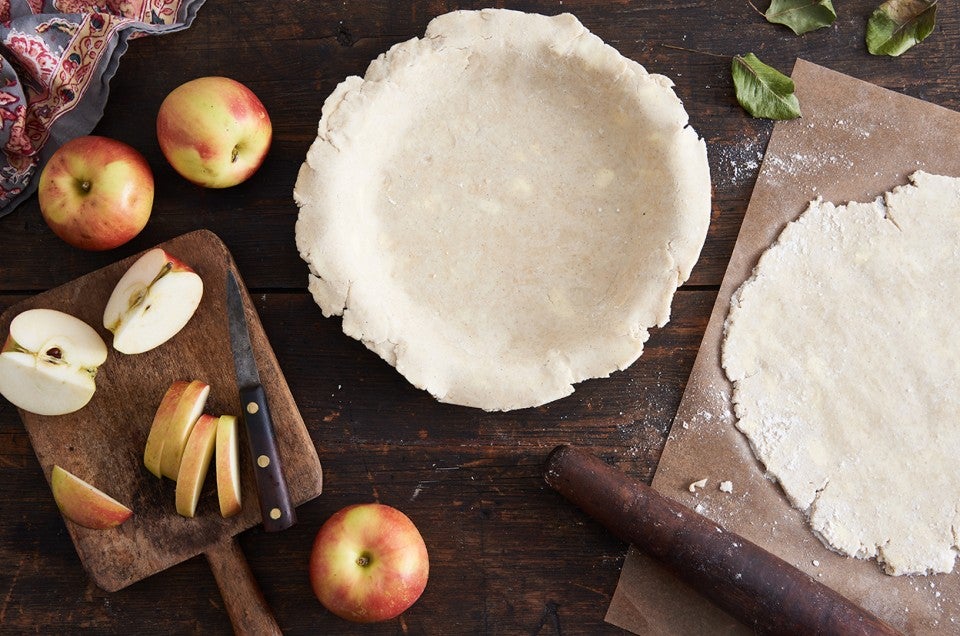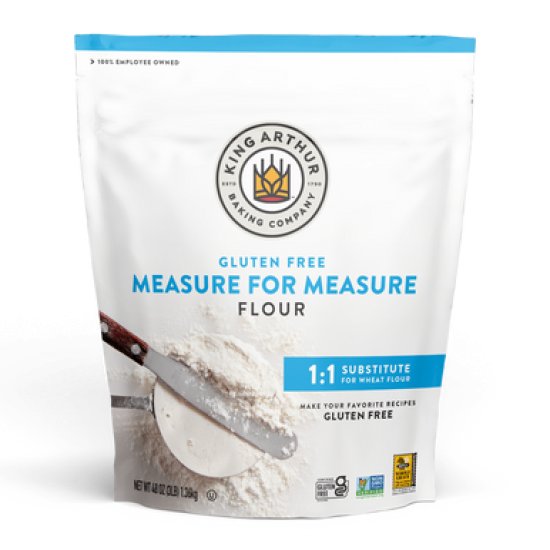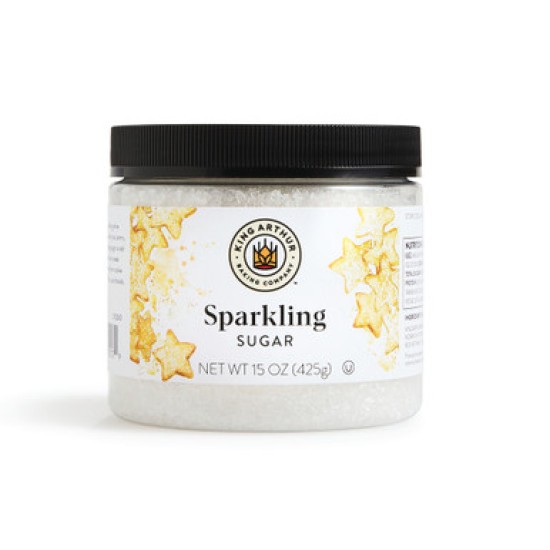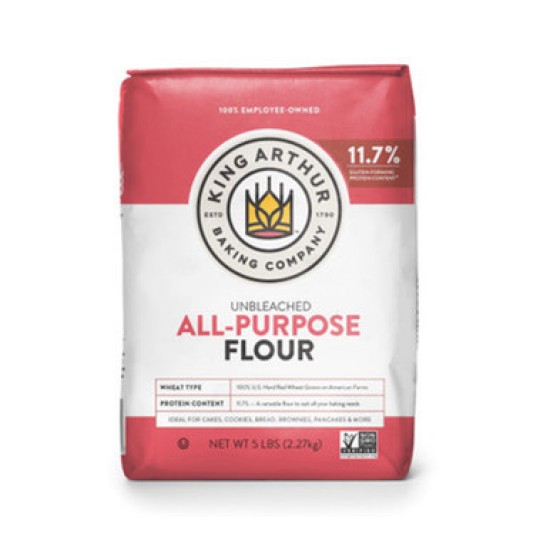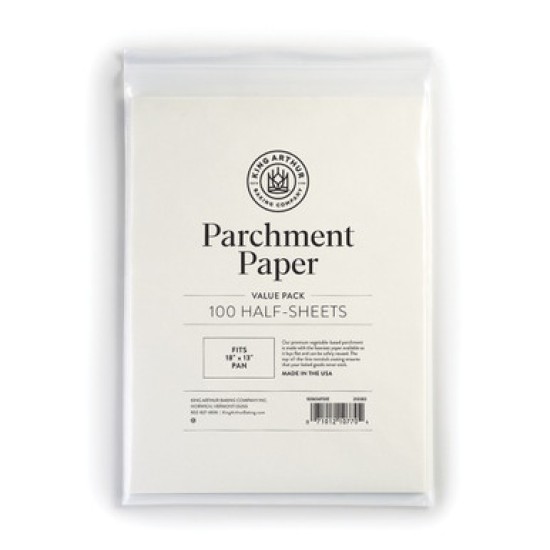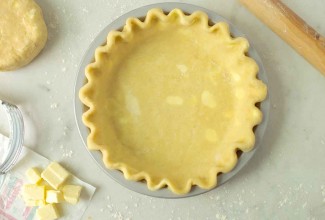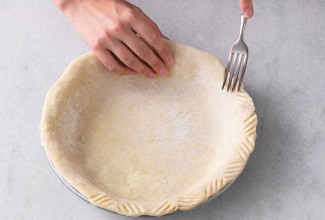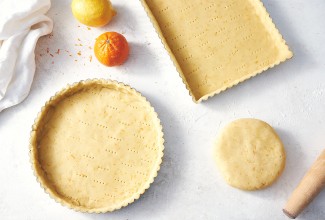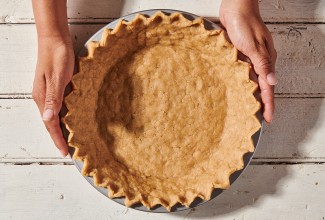-
Weigh your flour, or measure it by gently spooning it into a cup, then sweeping off any excess.
-
In a medium-sized mixing bowl, whisk together the flour and salt.
-
Add the shortening, working it in until the mixture is evenly crumbly, like coarse beach sand; you want everything thoroughly combined.
-
Cut the butter into small (about 1/2") cubes.
-
Add the butter to the flour mixture, and work it in roughly with your fingers, a pastry cutter, or a mixer. Don't be too thorough; the mixture should be quite uneven, with big chunks of butter in among the smaller ones. People get nervous about pie crust, and in their anxiety they tend to work the dough too much. Working the butter in completely makes a mealy crust rather than a flaky one.
-
Drizzle 4 tablespoons of water over the flour mixture, tossing gently to combine.
-
Add enough additional water to make a chunky, fairly cohesive mixture. It should hold together when you gather a bit up and squeeze it in your hand. Beware of kneading the pastry too much and/or adding too much water, as this will toughen the crust.
-
Gently shape the pastry into a cohesive mass. Or before shaping, take it a step further: Transfer the shaggy mixture to a piece of parchment paper. Press it into a rough rectangle and fold the dough into thirds, like a business letter. If necessary, spritz any dry areas with cold water and flatten and fold again, repeating the process until all errant bits of dough have been incorporated. Folding the dough in this fashion will create more flaky layers in your final crust.
-
Divide the dough in half. Gather each piece into a rough disk. Smooth the disks; it's OK if they have a few cracks in the surface. Smooth their edges by running the disks along a floured surface like a wheel.
-
Wrap the crusts in plastic or your favorite reusable storage wrap. Chill for 30 minutes, or up to overnight. Or wrap in aluminum foil over the plastic, and freeze for up to two months.
-
When you're ready to make pie, remove the crusts from the refrigerator or freezer, leaving them wrapped. Allow to thaw (if frozen) or warm a bit (if chilled longer than 30 minutes), until softened enough to roll but still cold to the touch.
-
Sprinkle a piece of parchment or waxed paper with flour. Working with one piece of dough at a time, place it on the floured parchment/plastic, and lightly flour the surface of the dough. Cover with another piece of parchment/plastic. For a standard 9" pie, roll the dough into a 12" to 13" round. If you're making a double-crust pie, repeat with the remaining piece of dough.
-
Lightly grease the pie pan with non-stick spray; this will make taking the slices out of the pan easier later. Fold the crust in quarters and place it in the pan. Or you can simply pick it up with a large spatula and move it that way.
-
For a single-crust pie, fold the edge of the crust under itself, gently squeezing it together. Crimp as desired. It's nice to make a tall crimp, as the filling for a single-crust pie is usually fairly liquid (think pumpkin or custard), and it's good to have that tall "dam."
-
For a double-crust pie, use a pair of scissors to trim the bottom crust to within 1/2” of the rim of the pan. Once you've added the filling, roll the top crust into a 12" circle and center it over the filling.
-
Bring the top crust down and over the edge of the bottom crust, pressing the two together to make a ridge of dough around the inside rim of the pan. Using the tines of a fork, gently press the crust down onto the pan’s rim all the way around the circumference of the pie. Or make a taller “finger crimp”: Using the pointer finger of one hand on one side of the ridge of dough, and the thumb and pointer finger of the other hand on the other side, press to make even indentations along the entire edge of the pie crust. At this point, it helps to return the pie to the refrigerator for 20 to 30 minutes; this chills the fat, which ultimately increases the crust's flakiness.
-
Just before baking, brush the top crust with milk or water and sprinkle it with coarse sparkling sugar, cinnamon sugar, or granulated sugar. Make a series of cuts to allow steam to escape. Three or four simple parallel cuts are fine, but feel free to do something more decorative if you like.
-
Bake according to the pie recipe's directions. Enjoy!
